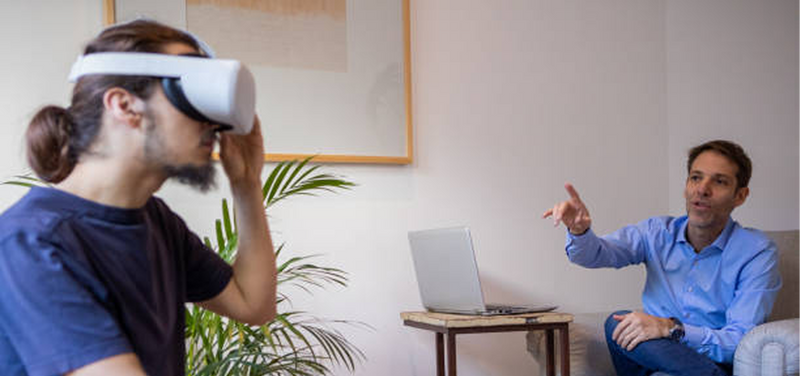Virtual Reality Exposure Therapy: Uses and Psychology

What is Virtual Reality Exposure Therapy?
Virtual Reality Exposure Therapy (VRET) is a form of psychological treatment that uses immersive technology to help people confront fears, phobias, and traumatic experiences in a safe and controlled environment. Instead of asking a patient to directly face a feared situation in real life, therapists use virtual simulations to recreate those experiences. The goal is to gradually reduce anxiety and help individuals develop healthier coping mechanisms.
In simple terms, virtual reality exposure therapy is a form of cognitive-behavioral treatment that combines traditional exposure therapy with advanced VR software. By wearing a headset, a patient can be placed in realistic scenarios such as flying on an airplane, walking across a tall bridge, or speaking to a crowd. Over time, repeated exposure helps reduce fear and avoidance behaviors.
This answers the basic question many students and patients ask: what is virtual reality exposure therapy? It is a safe, controlled, and highly effective psychological technique that bridges technology with mental health care.
Virtual Reality Exposure Therapy: Psychology Definition
From a clinical perspective, virtual reality exposure therapy psychology definition refers to the therapeutic process of exposing individuals to anxiety-provoking stimuli through virtual reality technology. In psychology, exposure therapy is based on the principle of habituation—when someone repeatedly faces a feared stimulus, the anxiety response gradually decreases.
Therefore, virtual reality exposure therapy psychology is an extension of this principle, using computer-generated environments instead of real-world exposure. The benefit is that therapists can control the intensity, duration, and repetition of the exposure, making it more adaptable to the patient’s needs.
In educational settings, such as AP Psychology, the virtual reality exposure therapy AP psychology definition describes it as a behavioral technique that applies technology to simulate feared environments for therapeutic purposes.
Virtual Reality Exposure Therapy Example
To better understand how it works, imagine a patient with a fear of flying. Instead of buying plane tickets and boarding an actual flight, the therapist uses VR software to place the patient in a virtual airplane cabin. At first, the patient may just sit quietly in the seat while hearing engine sounds. Later sessions may simulate take-off, turbulence, and landing. Over time, this controlled exposure reduces anxiety and helps the patient manage real flights with greater ease.
This virtual reality exposure therapy example shows how powerful immersive technology can be when applied in a therapeutic setting. Similar approaches are used for fear of heights, public speaking, social anxiety, and post-traumatic stress disorder.

Virtual Reality Exposure Therapy for PTSD
One of the most researched and successful applications is virtual reality exposure therapy for PTSD. Post-Traumatic Stress Disorder often involves distressing flashbacks, avoidance behaviors, and heightened anxiety triggered by memories of traumatic events. Traditional exposure therapy can be difficult, especially if real-life re-exposure to trauma reminders is not possible or safe.
With VR, therapists can recreate combat zones for veterans, accident scenes for trauma survivors, or other environments related to the patient’s experience. The exposure is gradual and controlled, helping patients process memories while feeling secure in the therapist’s office. This makes VRET for PTSD a powerful alternative to traditional therapy methods, supported by growing scientific evidence.
Virtual Reality Exposure Therapy for Dental Anxiety
Another unique application is in dentistry. Studies, including those conducted with Czech patients, show that virtual reality exposure therapy for dental anxiety can significantly reduce fear of dental procedures. Patients can be exposed virtually to dental offices, the sound of drills, or the experience of sitting in a dentist’s chair. This preparation reduces stress before actual appointments and helps patients overcome avoidance behaviors that prevent them from seeking proper dental care.
By simulating these situations ahead of time, VR allows individuals to desensitize themselves gradually, making real visits far less overwhelming.
Why Might a Therapist Use Virtual Reality Exposure Therapy?
Therapists may choose virtual reality exposure therapy (VRET) for several reasons. Traditional exposure therapy can sometimes be impractical, unsafe, or even impossible. For example, someone with a fear of flying cannot realistically board planes repeatedly as part of treatment, and a combat veteran cannot return to a battlefield for exposure therapy.
VR solves these challenges by creating safe, controlled, and repeatable simulations. A therapist can gradually increase the intensity of exposure, pause whenever necessary, and tailor the experience to the patient’s comfort level. This flexibility is one of the strongest reasons why a therapist might use virtual reality exposure therapy in clinical practice.
SVRET: Social Virtual Reality Exposure Therapy
While many people associate VRET with phobias or PTSD, it is also highly effective for social anxiety. Social Virtual Reality Exposure Therapy (SVRET) uses VR to simulate social interactions such as speaking to groups, attending a party, or engaging in workplace conversations. Patients can practice skills and reduce anxiety in these virtual situations before applying them in real life.
Research shows that SVRET is particularly useful for individuals who struggle with public speaking, job interviews, or everyday social interactions. By repeating these experiences in VR, patients gain confidence and reduce the avoidance behaviors that hold them back in daily life.
Virtual Reality Exposure Therapy Software
The effectiveness of VRET depends heavily on the software that powers it. Virtual reality exposure therapy software creates realistic environments tailored to specific fears or traumas. Some programs simulate airplanes, tall buildings, or driving scenarios, while others focus on military settings or medical procedures.
Modern VR therapy software also allows therapists to control every detail—background sounds, lighting, and even the presence of other characters. This level of customization ensures that exposure is gradual and personalized. It also helps track patient progress over time, making the treatment measurable and adaptive.

Virtual Reality Exposure Therapy is Similar To
In psychology, virtual reality exposure therapy is most similar to traditional exposure therapy, which is a core component of cognitive-behavioral therapy (CBT). Both approaches rely on the principle that repeated exposure to a feared situation decreases anxiety over time. The difference is that VR introduces technology as a bridge, making the process more accessible and flexible.
Therefore, when students ask about virtual reality exposure therapy definition psychology, the best answer is that it is essentially an advanced form of exposure therapy, enhanced by immersive simulations.
FAQs on Virtual Reality Exposure Therapy
1. What is the psychology definition of virtual reality exposure therapy?
It is a therapeutic method that uses VR simulations to help patients confront fears, based on the principles of exposure therapy in psychology.
2. Is virtual reality exposure therapy effective for PTSD?
Yes. Virtual reality exposure therapy for PTSD has shown strong results, particularly for veterans and trauma survivors. It allows safe re-exposure to trauma cues in a controlled environment.
3. How does virtual reality exposure therapy work for dental anxiety?
Studies, including those on Czech patients, show that VRET can reduce fear of dental visits by gradually exposing patients to dental environments in VR.
4. What is SVRET?
Social Virtual Reality Exposure Therapy (SVRET) is a type of VRET designed to help with social anxiety. It recreates interactions like parties or public speaking events.
5. What is an example of VRET in practice?
A patient with a fear of flying can use VR to sit in a simulated airplane, hear engine noises, and experience turbulence—all while safely in a therapist’s office.

The Future of Virtual Reality Exposure Therapy
Virtual reality exposure therapy definition goes beyond textbooks—it is a groundbreaking approach that blends psychology with technology. By creating safe yet realistic simulations, VRET allows patients to face fears that would otherwise be difficult or impossible to confront. From PTSD and social anxiety to dental phobia and everyday fears, its applications are wide-ranging and supported by a growing body of research.
As VR technology becomes more advanced and accessible, therapists around the world are likely to adopt it as a standard tool. Whether through VRET software, SVRET for social anxiety, or specialized programs for trauma, this therapy is shaping the future of mental health care.




